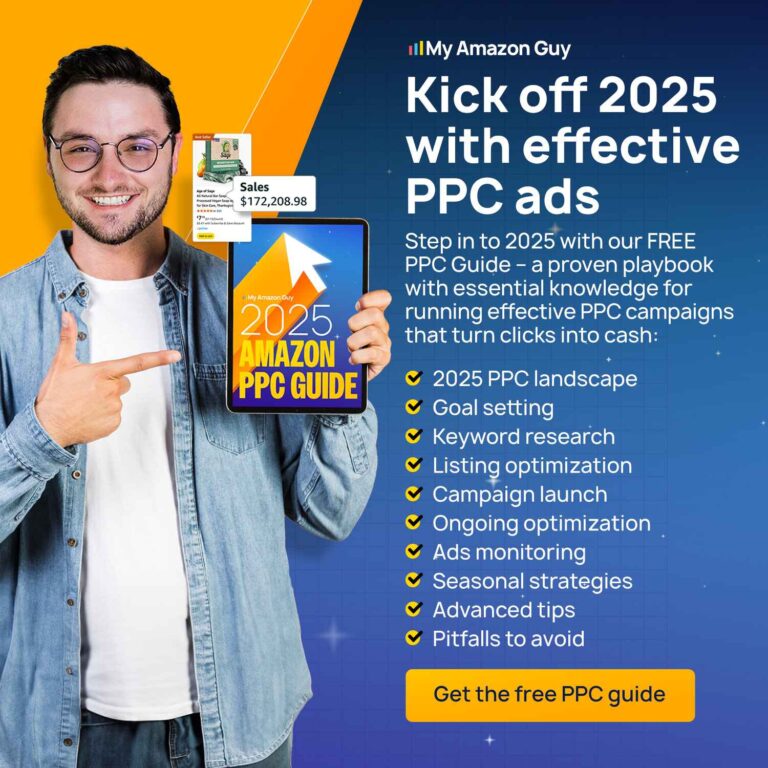Launching an Amazon PPC campaign the smart way, by understanding the risks and workarounds before you even click “start.”
Launching your Amazon PPC (pay-per-click) ad campaign sounds simple—set a budget, pick some keywords, and watch the sales roll in. But in reality, many sellers waste thousands on ineffective auto and manual campaign ads due to poor timing, bad keyword choices, and mismanaged bids.
Without a clear strategy, your ads burn through cash with little to show for it—high impressions, low conversions, and a draining ACoS. Worse, your competitors, who understand seasonal trends and bidding strategies, snap up the buyers you’re missing.
The key to profitable PPC campaigns is understanding consumer behavior, structuring your ads correctly, and continuously optimizing performance. If you’re ready to take the guesswork out of PPC and maximize your ROI, our Amazon agency can help you run campaigns that convert.
Table of Contents
1. Choosing the Right Ad Type Before Launching an Amazon PPC Ad Campaign
Each campaign type (Sponsored Products, Sponsored Brands, Sponsored Display) serves different purposes. Choosing the wrong type can lead to inefficient spending and low visibility in search results—a problem our Amazon PPC guide, designed to help launch Amazon PPC campaigns with the most appropriate ad type, addresses directly.
Free Amazon PPC Guide – Limited Time Offer!
Unlock expert PPC strategies with our free guide—learn how to analyze and optimize campaigns effectively, backed by $1.2 billion in annual ad management experience.
Choose an Ad Type Based on Your Goal
- Sponsored Products – High Sales Potential but Competitive
Best for increasing sales and ranking, but bidding wars on popular keywords can drive up costs.
Risks:
- High CPC in competitive niches
- Can drain budget quickly without strong conversion rates
Workarounds:
- Focus on long-tail keywords for better ROI
- Optimize listings to maximize conversions before launching ads
2. Sponsored Brands – Brand Awareness with a Catch
Great for promoting multiple products, but ineffective if your brand lacks recognition or has weak visuals.
Risks:
- Higher cost with lower direct conversions
- Requires strong creatives to stand out
Workarounds:
- Use engaging visuals and compelling ad copy
- Target branded keywords to capture existing demand
3. Sponsored Display – Retargeting with Variable Results
Ideal for bringing back interested shoppers, but low engagement can lead to wasted spend.
Risks:
- Ads may show to irrelevant audiences
- Higher CPC without guaranteed conversions
Workarounds:
- Use audience segmentation to refine targeting
- Test different creatives to improve engagement rates
4. Sponsored TV – Best for Expanding to Streaming Audiences
Sponsored TV ads on platforms like Prime Video can drive brand awareness and conversions, but they require careful testing and optimization to justify the cost.
Risks:
- High upfront costs with no immediate ROI
- Difficult to track direct sales impact
- Poor targeting or weak creatives can lead to wasted spend
Workarounds:
- Optimize video length, messaging, and visuals for engagement
- Test different targeting strategies to refine audience reach
- Measure success by tracking total sales lift, not just ad-attributed revenue
Key takeaways from Mina Elias, CEO of Trivium Group, about Sponsored TV:
- 110% higher purchase rates when shoppers see a Sponsored TV ad before a Sponsored Product ad.
- 58% more new-to-brand conversions, increasing long-term customer retention.
- Testing is key—optimize video length, creatives, and targeting for the best ROI.
- Sales impact grows over time, even after turning off ads.
Selecting the Best Ad Match Type
Amazon PPC is complex, even for experienced sellers. Many struggle with ad optimization, which is why entire agencies exist solely to manage advertising campaigns.
Choosing the Right Match Type – Avoiding Costly Mistakes
Using the wrong match type in Amazon PPC can drain your budget with irrelevant clicks or limit your reach, reducing sales potential.
Risks & Workarounds:
Exact Match – High Conversions but Limited Reach
- Risk: Too restrictive, missing potential sales from slight keyword variations.
- Workaround: Use for highly relevant, high-intent searches but supplement with phrase match for additional reach.
Example: “Yellow balloon” only appears for that exact phrase, missing searches like “yellow party balloon.”
Phrase Match – Balanced Reach but Needs Monitoring
- Risk: May still trigger ads for less relevant searches, increasing ACoS.
- Workaround: Regularly review search term reports and add negative keywords to filter out irrelevant traffic.
Example: “Yellow balloon for parties” matches, but “balloon yellow” does not, keeping searches relevant.
Broad Match – Maximum Reach but High Risk of Wasted Spend
- Risk: Can trigger unrelated searches, leading to wasted ad spend and poor conversion rates.
- Workaround: Use with strong negative keywords to filter out irrelevant terms and refine targeting over time.
Example: “Yellow balloon” could trigger “balloon bouquet,” “golden balloons,” or “party balloons,” requiring careful review.
Broad match bids are often significantly cheaper than exact match, leading to lower ACoS and more efficient ad spend.
To maximize broad match effectiveness, an Amazon seller must regularly review search term reports and add negative keywords to filter out irrelevant traffic.
2. Considering Seasonality When Launching An Amazon PPC Campaign
Seasonality impacts consumer behavior, ad performance, and profitability on Amazon. Ignoring it leads to wasted ad spend, low engagement, and missed sales. Running ads at the wrong time results in poor conversions and high ACoS.
Workaround: Use past sales data to adjust bids and budgets based on demand.
Example – Q1 Seasonality in PPC:
- January – Focus on New Year’s resolutions, fitness trends, and post-holiday clearance as shoppers use gift cards and look for deals.
- February – Target Valentine’s Day buyers and winter clearance shoppers, adjusting bids for increased competition on gift-related searches.
- March – Shift to early spring promotions and St. Patrick’s Day marketing, capturing shoppers preparing for seasonal transitions.
To maintain PPC efficiency year-round, sellers must analyze seasonal trends, adjust ad budgets accordingly, and refine keyword strategies. Planning around these fluctuations ensures maximum visibility and ROI across all quarters.
3. Launching an Amazon PPC Campaign at the Right Time
Launching PPC too early wastes budget, while waiting too long delays momentum. To maximize efficiency, ensure your product listing is fully optimized with high-quality images, A+ content, a Brand Store, and at least one review.
Before launching PPC, ensure
- Complete listing optimization – Six high-quality images, compelling bullet points, and A+ content.
- Brand Registry & Storefront – Prevent lost traffic to competitor ads.
- FBA Fulfillment & Prime Badge – Boosts conversion rates.
- At least one review – Increases trust and doubles conversion rates.
Best Timing for PPC Launch
- Day One (if optimized) – If your listing is ready, start PPC immediately to generate traction.
- Key Shopping Seasons (e.g., Q4) – High traffic periods like Black Friday justify early ad spending regardless of reviews.
- Post-Optimization (if not ready at launch) – Wait until your listing is fully optimized before investing heavily in ads.
4. Learning How to Bid Correctly when Launching Amazon PPC Campaign
High bids don’t always mean high conversions. Overbidding can burn through your daily budget, while underbidding makes your ads invisible on search results and detail pages.
Amazon PPC Bidding Strategies for Efficiency
1. Best Days & Times to Bid
- Monday-Wednesday perform best; weekends see lower conversions (especially for B2B).
- Peak conversions: 9 AM – 12 PM PST, Peak traffic: 4 PM – 6 PM PST (higher volume, lower conversion).
2. Optimize Bids Smartly
- Lower bids during low-converting hours (late night/early morning).
- Increase bids for high-converting time slots and automate adjustments based on data.
5. Knowing Which Key Amazon Ads Metrics to Track
Tracking the right PPC metrics ensures efficient ad spend and better conversions, but ignoring key data points can lead to wasted budget and missed opportunities, such as on display ads. Here’s what to monitor, the risks of neglecting them, and how to fix potential issues.
Essential Amazon PPC Metrics & Optimization Tips
ACoS (Advertising Cost of Sales) – Measures ad spend relative to sales.
- High ACoS means low profitability and wasted budget.
- Optimize bids, keywords, and listing quality; cut underperforming ads.
TACoS (Total Advertising Cost of Sales) – Evaluates how ads impact total revenue (not just PPC sales).
- High TACoS suggests organic sales aren’t growing, making ads unsustainable.
- Invest in listing optimization, SEO, and brand awareness to improve organic rankings.
Conversion Rate (CVR) – Measures how many clicks turn into sales.
- Low CVR means your listing isn’t converting shoppers into buyers.
- Improve images, bullet points, A+ content, and pricing to boost conversions.
Click-Through Rate (CTR) – Shows how well your ad attracts clicks.
- Low CTR suggests poor ad relevance or weak visuals.
- Test different main images, ad copy, and high-performing keywords.
Cost Per Click (CPC) – Tracks how much each click costs.
- High CPC drains your ad budget without guaranteed conversions.
- Lower bids on low-performing keywords, optimize targeting, and use negative keywords.
Cost Per Acquisition (CPA) – Measures how much you spend per customer gained.
- High CPA means acquiring customers is too expensive.
- Improve ad targeting, offer bundles or discounts, and leverage remarketing.
6. Learning from Your Competitors Without Copying Them
Tracking the right PPC metrics ensures efficient ad spend and better conversions, but ignoring key data points can lead to wasted budget and missed opportunities, such as on display ads. Here’s what to monitor, the risks of neglecting them, and how to fix potential issues.
Competitor research helps identify winning strategies without reinventing the wheel.
Blindly copying competitors without data can lead to costly mistakes.
Workaround:
- Use tools like Helium 10 or Jungle Scout to analyze competitor PPC strategies.
- Identify gaps in competitor ad placements and target their weaknesses.
- Test unique selling points (USPs) that competitors aren’t highlighting.
Take Control of Your Amazon PPC Success
Launching an Amazon PPC campaign without a strategy can drain your budget fast. With the right approach—optimized listings, precise keyword targeting, and data-driven bidding—you can turn clicks into profitable sales.
Don’t leave your ad spend to chance. Let our Full Service Amazon Agency help you build and manage high-converting PPC campaigns. Contact us today and start scaling your sales the smart way!
Launching an Amazon PPC Campaign Q&As
How do you structure a PPC campaign?
Failing to set up Amazon PPC correctly can drain your budget with low conversions and wasted ad spend. Watch this video to get it right!
Is PPC worth it on Amazon?
Not using Amazon PPC ads means losing visibility, missing out on sales, and falling behind competitors. Read this article to see why PPC is a must for sellers!
What is a good budget for Amazon PPC?
A good Amazon PPC budget depends on your goals, competition, and profit margins—but smart allocation is key to maximizing ROI. Watch this video for the 2025 PPC allocation guide!






